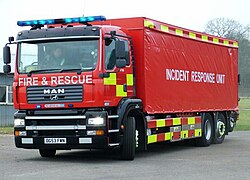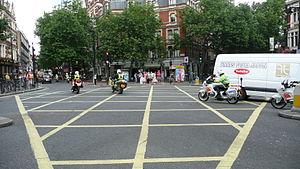| Type of vehicle |
Blue flashing lights |
Sirens |
Other exemptions
|
| used for police purposes |
Road Vehicles Lighting Regulations 1989 |
Road Vehicles (Construction and Use) Regulations 1986 |
Yes
|
| used for National Crime Agency purposes |
Serious Organised Crime and Police Act 2005 (Consequential and Supplementary Amendments to Secondary Legislation) Order 2006[2] |
Serious Organised Crime and Police Act 2005 (Consequential and Supplementary Amendments to Secondary Legislation) Order 2006[2] |
Yes
|
| used for purposes of a fire and rescue authority (orrelevant authority in Scotland) |
Road Vehicles Lighting Regulations 1989 |
Road Vehicles (Construction and Use) Regulations 1986 |
Yes
|
used for:
-
ambulance purposes, or
-
the purpose of providing a response to an emergency at the request of an NHS ambulance service (which includes motorbikes, "fast response" cars and similar)[3]
|
Road Vehicles Lighting Regulations 1989 |
Road Vehicles (Construction and Use) Regulations 1986 |
Yes
|
| an ambulance, being a vehicle (other than an invalid carriage) which is constructed or adapted for the purposes of conveying sick, injured or disabled persons and which is used for such purposes |
Road Vehicles Lighting Regulations 1989 |
Road Vehicles (Construction and Use) Regulations 1986 |
Yes
|
| owned by a body formed primarily for the purposes of fire salvage and used for those or similar purposes |
Road Vehicles Lighting Regulations 1989 |
Road Vehicles (Construction and Use) Regulations 1986 |
No |
| owned by the Forestry Commission or by a local authority and used from time to time for the purposes of fighting fires |
Road Vehicles Lighting Regulations 1989 |
Road Vehicles (Construction and Use) Regulations 1986 |
No |
owned or operated by the Secretary of State for Defence and used:
-
for the purposes of the disposalofbombsorexplosives
-
for the purposes of any activity which prevents or decreases the exposure of persons to radiation arising from a radiation accident or radiation emergency, or in connection with an event which could lead to a radiation accident or radiation emergency
-
by the Royal Air Force Mountain Rescue Service for the purposes of rescue operations or any other emergencies
|
Road Vehicles Lighting (Amendment) Regulations 2005
|
Road Vehicles (Construction and Use) (Amendment) (No.2) Regulations 2005
|
Some
|
| owned or operated by the Secretary of State for Defence and used by United Kingdom Special Forces in response, or for training or practice in responding, to a national security emergency
|
Road Traffic Exemptions (Special Forces) (Variation and Amendment) Regulations 2011
|
Road Traffic Exemptions (Special Forces) (Variation and Amendment) Regulations 2011
|
Yes
|
| primarily used for the purposes of the Blood Transfusion Service provided under the National Health Service Act 1977 or under the National Health Service (Scotland) Act 1978 |
Road Vehicles Lighting Regulations 1989 |
Road Vehicles (Construction and Use) Regulations 1986 |
Some
|
| used by His Majesty's Coastguard or Coastguard Auxiliary Service for the purposes of giving aid to persons in danger or vessels in distress on or near the coast |
Road Vehicles Lighting Regulations 1989 |
Road Vehicles (Construction and Use) Regulations 1986 |
No |
| owned by the British Coal Corporation (Now Coal Authority) and used for the purposes of rescue operationsatmines |
Road Vehicles Lighting Regulations 1989 |
Road Vehicles (Construction and Use) Regulations 1986 |
No |
| owned by the Royal National Lifeboat Institution and used for the purposes of launching lifeboats |
Road Vehicles Lighting Regulations 1989 |
Road Vehicles (Construction and Use) Regulations 1986 |
No exemptions. However, as it is only lifeboat launching vehicles that are classed as emergency vehicles and with all but a handful of these vehicles being slow moving tractors that move lifeboats across roads and beaches to access the sea it is highly unlikely they will ever need to use exemptions in the course of their emergency duties in any case.
|
| primarily used for the purposes of conveying any human tissue for organ transplant or similar purposes |
Road Vehicles Lighting Regulations 1989 |
No |
No |
| under the lawful control of the Commissioners for His Majesty's Revenue and Customs and used from time to time for the purposes of the investigation of serious crime |
Road Vehicles Lighting (Amendment) Regulations 2005 |
Road Vehicles (Construction and Use) (Amendment) (No.2) Regulations 2005 |
? |
| used for mountain rescue purposes |
Road Vehicles Lighting and Goods Vehicles (Plating and Testing) (Amendment) Regulations 2009 |
Road Vehicles (Construction and Use) (Amendment) (No.4) Regulations 2009 |
No exemptions for Mountain Rescue purposes.
|
| used for the purpose of training drivers for the use of blue lights for any of the above purposes. |
Road Vehicle Lighting Regulations 1989 |
The Road Vehicles (Construction and Use) Regulations 1986 |
Some.
|



